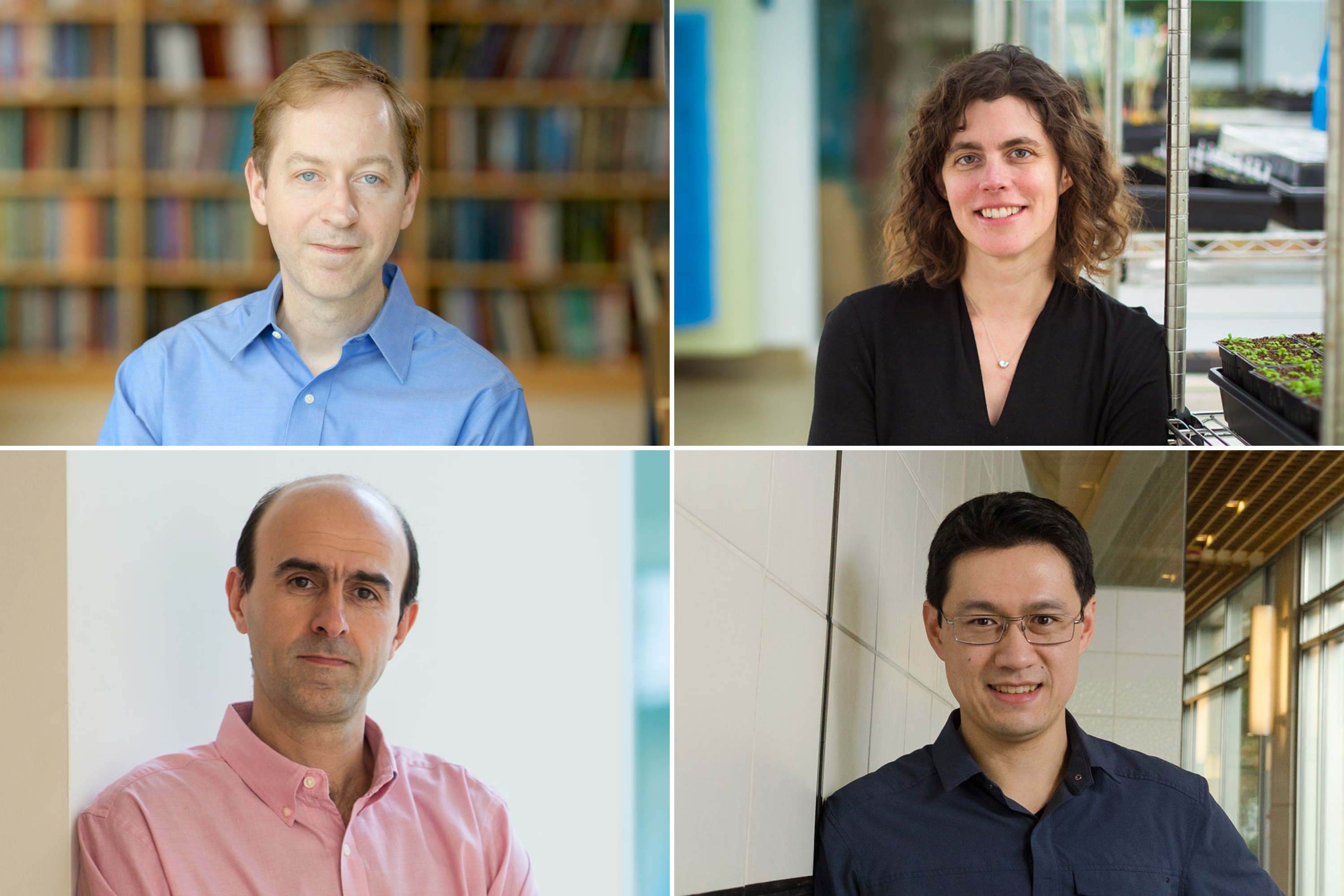School of Science
2024-07-23 15:35:00
news.mit.edu

The Howard Hughes Medical Institute (HHMI) today announced its 2024 investigators, four of whom hail from the School of Science at MIT: Steven Flavell, Mary Gehring, Mehrad Jazayeri, and Gene-Wei Li.
Four others with MIT ties were also honored: Jonathan Abraham, graduate of the Harvard/MIT MD-PhD Program; Dmitriy Aronov PhD ’10; Vijay Sankaran, graduate of the Harvard/MIT MD-PhD Program; and Steven McCarroll, institute member of the Broad Institute of MIT and Harvard.
Every three years, HHMI selects roughly two dozen new investigators who have significantly impacted their chosen disciplines to receive a substantial and completely discretionary grant. This funding can be reviewed and renewed indefinitely. The award, which totals roughly $11 million per investigator over the next seven years, enables scientists to continue working at their current institution, paying their full salary while providing financial support for researchers to be flexible enough to go wherever their scientific inquiries take them.
Of the almost 1,000 applicants this year, 26 investigators were selected for their ability to push the boundaries of science and for their efforts to create highly inclusive and collaborative research environments.
“When scientists create environments in which others can thrive, we all benefit,” says HHMI president Erin O’Shea. “These newest HHMI Investigators are extraordinary, not only because of their outstanding research endeavors but also because they mentor and empower the next generation of scientists to work alongside them at the cutting edge.”
Steven Flavell
Steven Flavell, associate professor of brain and cognitive sciences and investigator in the Picower Institute for Learning and Memory, seeks to uncover the neural mechanisms that generate the internal states of the brain, for example, different motivational and arousal states. Working in the model organism, the C. elegans worm, the lab has used genetic, systems, and computational approaches to relate neural activity across the brain to precise features of the animal’s behavior. In addition, they have mapped out the anatomical and functional organization of the serotonin system, mapping out how it modulates the internal state of C. elegans. As a newly named HHMI Investigator, Flavell will pursue research that he hopes will build a foundational understanding of how internal states arise and influence behavior in nervous systems in general. The work will employ brain-wide neural recordings, computational modeling, expansive research on neuromodulatory system organization, and studies of how the synaptic wiring of the nervous system constrains an animal’s ability to generate different internal states.
“I think that it should be possible to define the basis of internal states in C. elegans in concrete terms,” Flavell says. “If we can build a thread of understanding from the molecular architecture of neuromodulatory systems, to changes in brain-wide activity, to state-dependent changes in behavior, then I think we’ll be in a much better place as a field to think about the basis of brain states in more complex animals.”
Mary Gehring
Mary Gehring, professor of biology and core member and David Baltimore Chair in Biomedical Research at the Whitehead Institute for Biomedical Research, studies how plant epigenetics modulates plant growth and development, with a long-term goal of uncovering the essential genetic and epigenetic elements of plant seed biology. Ultimately, the Gehring Lab’s work provides the scientific foundations for engineering alternative modes of seed development and improving plant resiliency at a time when worldwide agriculture is in a uniquely precarious position due to climate changes.
The Gehring Lab uses genetic, genomic, computational, synthetic, and evolutionary approaches to explore heritable traits by investigating repetitive sequences, DNA methylation, and chromatin structure. The lab primarily uses the model plant A. thaliana, a member of the mustard family and the first plant to have its genome sequenced.
“I’m pleased that HHMI has been expanding its support for plant biology, and gratified that our lab will benefit from its generous support,” Gehring says. “The appointment gives us the freedom to step back, take a fresh look at the scientific opportunities before us, and pursue the ones that most interest us. And that’s a very exciting prospect.”
Mehrad Jazayeri
Mehrdad Jazayeri, a professor of brain and cognitive sciences and an investigator at the McGovern Institute for Brain Research, studies how physiological processes in the brain give rise to the abilities of the mind. Work in the Jazayeri Lab brings together ideas from cognitive science, neuroscience, and machine learning with experimental data in humans, animals, and computer models to develop a computational understanding of how the brain creates internal representations, or models, of the external world.
Before coming to MIT in 2013, Jazayeri received his BS in electrical engineering, majoring in telecommunications, from Sharif University of Technology in Tehran, Iran. He completed his MS in physiology at the University of Toronto and his PhD in neuroscience at New York University.
With his appointment to HHMI, Jazayeri plans to explore how the brain enables rapid learning and flexible behavior — central aspects of intelligence that have been difficult to study using traditional neuroscience approaches.
“This is a recognition of my lab’s past accomplishments and the promise of the exciting research we want to embark on,” he says. “I am looking forward to engaging with this wonderful community and making new friends and colleagues while we elevate our science to the next level.”
Gene-Wei Li,
Gene-Wei Li, associate professor of biology, has been working on quantifying the amount of proteins cells produce and how protein synthesis is orchestrated within the cell since opening his lab at MIT in 2015.
Li, whose background is in physics, credits the lab’s findings to the skills and communication among his research team, allowing them to explore the unexpected questions that arise in the lab.
For example, two of his graduate student researchers found that the coordination between transcription and translation fundamentally differs between the model organisms E. coli and B. subtilis. In B. subtilis, the ribosome lags far behind RNA polymerase, a process the lab termed “runaway transcription.” The discovery revealed that this kind of uncoupling between transcription and translation is widespread across many species of bacteria, a study that contradicted the long-standing dogma of molecular biology that the machinery of protein synthesis and RNA polymerase work side-by-side in all bacteria.
The support from HHMI enables Li and his team the flexibility to pursue the basic research that leads to discoveries at their discretion.
“Having this award allows us to be bold and to do things at a scale that wasn’t possible before,” Li says. “The discovery of runaway transcription is a great example. We didn’t have a traditional grant for that.”
Support Techcratic
If you find value in Techcratic’s insights and articles, consider supporting us with Bitcoin. Your support helps me, as a solo operator, continue delivering high-quality content while managing all the technical aspects, from server maintenance to blog writing, future updates, and improvements. Support Innovation! Thank you.
Bitcoin Address:
bc1qlszw7elx2qahjwvaryh0tkgg8y68enw30gpvge
Please verify this address before sending funds.
Bitcoin QR Code
Simply scan the QR code below to support Techcratic.

Please read the Privacy and Security Disclaimer on how Techcratic handles your support.
Disclaimer: As an Amazon Associate, Techcratic may earn from qualifying purchases.



















































































![Conquest of Space / I Married a Monster from Outer Space [Blu-ray]](https://techcratic.com/wp-content/uploads/2025/09/81Yx1UahVuL._SL1500_-360x180.jpg)














